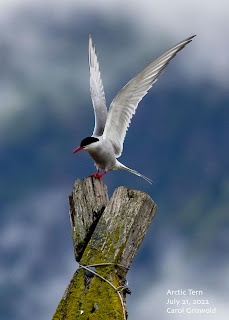Sunday, July 17, 2022 Lesser Yellowlegs, Pectoral Sandpiper, Black Turnstones, Arctic Terns
Seward, Alaska
Sunrise 5:06 am, sunset 11:04 pm, for a total day length of 17 hours and 58 minutes. Tomorrow will be 3 minutes and 55 seconds shorter. Cool temperatures prevailed with a low of 49 and a high of 56.
Fortunately, the weather alert for heavy and protracted rain all weekend did not apply to Seward for once. It did rain, up to 0.05” but not hard and not all day. I even saw a surreal blue eye in the shifting clouds this afternoon.
Dead lawns and wilted trees have miraculously revived under Nature’s gentle sprinkler, restoring the landscape to an array of greens with a dash of red from ripening elderberries, salmonberries, and devil’s club fruit. Fireweed blaze magenta, ever-reaching higher on the spike. After a brief reprieve on Monday, more rain is in the forecast as another laden low from the Bering Sea approaches.
I ventured out in the drizzle this afternoon, determined to check on the ARCTIC TERNS at the tidelands. Their work is done and soon they will be migrating to the southern hemisphere, chasing the sun. Soon, however, the rain stopped and I gladly left my wet umbrella in the car.
I heard the joyful cries of Terns and found 6 still rocketing along the shoreline, hovering expertly, swooping, and diving and about six more farther out. Three rose upwards in a noisy spiral, higher and higher. I felt it was a farewell, a literal detachment from the land, ready to join those that have already departed.
Two immaculate SEMIPALMATED PLOVERS poked through the mud, stop and start. A bit farther out, I was surprised to see a LESSER YELLOWLEGS with its small head and slender bill, snatching up tidbits on the incoming tide. I haven’t seen one since spring, and even then, not many or often. I heard its cousin, the GREATER YELLOWLEGS, a species that is more common and here all summer presumably nesting.
A lone immature BLACK-LEGGED KITTIWAKE paddled slowly away as I walked along the shore. Farther out, a mob of gulls suddenly mobilized en masse, rising up, screaming. A marauding Eagle? Not this time! The harbor crew was towing a fish-cleaning tote behind their skiff, emptying it offshore. Instant bird-feeder bedlam! I hope the crew all wore hats.
A few minutes later, I spotted two BLACK TURNSTONES and a juvenile PECTORAL SANDPIPER quietly working their way down the wrack line towards me. I immediately sat down to enjoy the show. Neither species is common here, though one Black Turnstone has been here since about July 10. Today, beach flies were on the menu.
The Pectoral Sandpiper was very aware of me, and cautiously eased its way past me, about 10 feet away, stopping to nab another fly or two as it went. I must have resembled an odd piece of driftwood that made weird clicking noises; the bird came right towards me to get flies, and actually passed back and forth several times. The Black Turnstones also crossed in front and flew over the invisible danger zone in front of me.
Finally, all three birds were safely on the same side, walking away, and I was able to resume my walk in the opposite direction. I noticed waves of beach flies rising from the wrack, sand, and cobble ahead of me as I walked. Somehow, maybe vibrations from my feet, or actual view of my gigantic form (can they see that far?) stirred them up. Such an abundant food source, if one had patience and skill to snap them up, one by one by one.
On Friday in the rain, I parked at the Waterfront to take a look at the bay between wiper swipes of my rain-spattered windshield. Black-legged Kittiwakes, Glaucous-winged Gulls, Short-billed Gulls and a few Arctic Terns and Double-Crested Cormorants flew past in small groups or singly, patrolling the beach and near shore waters. MARBLED MURRELETS popped up to call to one another before diving once again.
Suddenly, three or four heavyset not-gulls with long red bills flew past! I could not get out of the car fast enough! CASPIAN TERNS! I spent a great deal of time searching along the shore in vain, hoping for another view and photos. They could have kept flying along the shore all the way to Lowell Point and beyond. Tantalizing!
Mid-July is a time of change with migrants like shorebirds already passing through and local nesters like the Terns and Hummers getting ready to leave. Time is flying on feathered wings.
Happy Birding!
Carol Griswold
Seward Sporadic Bird Report Reporter




















































